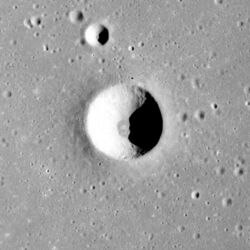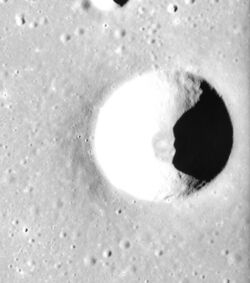Banting (crater)
Topic: Astronomy
 From HandWiki - Reading time: 5 min
From HandWiki - Reading time: 5 min
 Apollo 15 image | |
| Diameter | 6.4 km (4 miles) |
|---|---|
| Depth | 1.1 km (0.6 miles) |
| Colongitude | 346° at sunrise |
Banting is a small, bowl-shaped lunar impact crater located near the middle of the Mare Serenitatis on the Earth's moon.
Originally named Linné E, in 1973 the crater was renamed for Sir Frederick Banting[1] in honour of his outstanding medical contributions – the most famous being his discovery of insulin.[2] Linné itself, named after the 18th-century Swedish botanist Carl von Linné, lies to the west-northwest.
Naming
"Banting" was one of approximately fifty new names for lunar craters adopted by the International Astronomical Union in 1973. Choosing the names was the first step in the adoption of a new policy that involved broadening crater nomenclature.
The policy was created because of photographs taken by the Apollo spacecraft, which provided an extremely detailed and crater-populated lunar map, essentially proving that a greater variety of names would be needed. The practice that had previously been used was to name one large crater after a selected individual and to name the small craters around it with the same name followed by different letters of the alphabet.
The new policy allowed deceased scientists who had contributed to biological knowledge, like Dr. Banting – as well as scientists from other fields and contributors to culture and knowledge, such as writers, composers, and artists – to have craters named after them. Previously, only the names of astronomers, others who had made important contributions to astronomy, and historical philosophers had been used.[2][3]
Description
Banting is a 4-mile-wide (6.4 km)[2] "simple" impact crater.[4] It is located in the Sea of Serenity, which is also known as Mare Serenitatis, a large patch of lunar mare. Maria like Mare Serenitatis are dark, smooth areas created by lava pooling on the surface and then cooling, covering up any previously existing craters. They were originally called maria ("seas") because astronomers believed they were bodies of water.[5]
Banting is flanked by two U.S. lunar landing sites – those of Apollo 15 and 17 – which lie several hundred miles on either side of the crater.[2]
Viewing
Mare Serenitatis is frequently perceived to be the eastern eye of the Man in the Moon.[6][7] The Man in the Moon is on the near side of the Moon, which constantly faces Earth because of its tidally locked orbit.[8] This makes Sir Frederick's crater fairly central, since Mare Serenitatis is so easily viewed.
Despite its location, Banting is a very small crater and can be difficult to see. A telescope must be used, and viewing during certain lunar phases is crucial to seeing such small craters, as well. It is recommended that, while it is waxing, the moon be viewed around the time of its first quarter; while it is waning, it should be viewed just before its last quarter. Craters may also be conspicuous during a gibbous moon, when it is between quarter and full. These phases all provide just enough shadow to outline the details of the lunar surface without its being too dark, whereas the full moon is too bright, washing out all details.[9][10]
See also
References
- ↑ "Banting (crater)". Gazetteer of Planetary Nomenclature. USGS Astrogeology Research Program.
- ↑ 2.0 2.1 2.2 2.3 "Eight Canadians put their names on lunar map". The Toronto Star, September 27, 1974
- ↑ ”New Names on the Moon” Sky and Telescope. March, 1974
- ↑ "Earth Impact Database". www.passc.net. http://www.passc.net/EarthImpactDatabase/IntrotoImpacts.html.
- ↑ Astronomy for All Ages: Discovering the Universe through Activities for Children and Adults. Harrington, Philip S., and Edward Pascuzzi. Old Saybrook, CT: Globe Pequot, 1994. Print.
- ↑ “Sailing the Sea of Serenity”. Astronomy [v.23]. Kalmbach Publishing Company. January, 1995.
- ↑ "The Origins of the Man in the Moon". www.space.com. 9 February 2006. http://www.space.com/2036-origins-man-moon.html.
- ↑ "Looking at the Man in the Moon". www.caltech.edu. http://www.caltech.edu/content/looking-man-moon.
- ↑ "Observing the Moon". www.telescope.com. http://www.telescope.com/Observing-the-Moon/p/99805.uts.
- ↑ "How to See the Moon". www.space.com. 20 January 2012. http://www.space.com/14296-moon-telescope-viewing-skywatching-tips.html.
Further reading
- Andersson, L. E.; Whitaker, E. A. (1982). NASA Catalogue of Lunar Nomenclature. NASA RP-1097.
- Bussey, B.; Spudis, P. (2004). The Clementine Atlas of the Moon. New York: Cambridge University Press. ISBN 978-0-521-81528-4.
- Cocks, Elijah E.; Cocks, Josiah C. (1995). Who's Who on the Moon: A Biographical Dictionary of Lunar Nomenclature. Tudor Publishers. ISBN 978-0-936389-27-1. https://archive.org/details/isbn_9780936389271.
- McDowell, Jonathan (July 15, 2007). "Lunar Nomenclature". Jonathan's Space Report. http://host.planet4589.org/astro/lunar/.
- Menzel, D. H.; Minnaert, M.; Levin, B.; Dollfus, A.; Bell, B. (1971). "Report on Lunar Nomenclature by the Working Group of Commission 17 of the IAU". Space Science Reviews 12 (2): 136–186. doi:10.1007/BF00171763. Bibcode: 1971SSRv...12..136M.
- Moore, Patrick (2001). On the Moon. Sterling Publishing Co.. ISBN 978-0-304-35469-6. https://archive.org/details/patrickmooreonmo00patr.
- Price, Fred W. (1988). The Moon Observer's Handbook. Cambridge University Press. ISBN 978-0-521-33500-3.
- Rükl, Antonín (1990). Atlas of the Moon. Kalmbach Books. ISBN 978-0-913135-17-4.
- Webb, Rev. T. W. (1962). Celestial Objects for Common Telescopes (6th revised ed.). Dover. ISBN 978-0-486-20917-3. https://archive.org/details/celestialobjects00webb.
- Whitaker, Ewen A. (1999). Mapping and Naming the Moon. Cambridge University Press. ISBN 978-0-521-62248-6.
- Wlasuk, Peter T. (2000). Observing the Moon. Springer. ISBN 978-1-85233-193-1.
External links
- LTO-42A3 Banting — L&PI topographic map
 |
33 views | Status: cached on September 29 2024 01:27:00
↧ Download this article as ZWI file
 KSF
KSF

